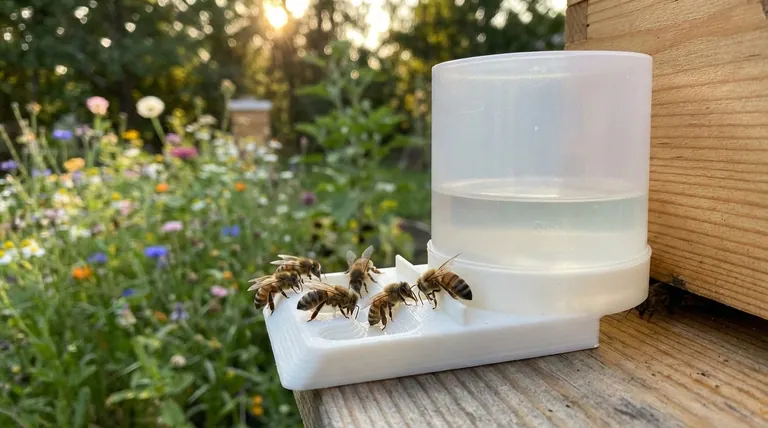At its core, a honey bee feeder is a form of risk management for your colony. It is a specialized tool designed to provide supplemental nutrition—typically sugar syrup or pollen substitutes—when natural nectar and pollen sources are scarce. Feeders are used to prevent starvation, maintain colony strength during difficult periods, and strategically stimulate growth when conditions demand it.
The purpose of a feeder extends beyond simply providing food. It is a strategic instrument for managing colony health, bridging gaps in the natural environment, and ensuring the long-term viability of your hives. However, improper use can create more problems than it solves.

The Strategic Goals of Supplemental Feeding
Understanding when and why to feed is more important than the act of feeding itself. Each application serves a distinct purpose in the lifecycle and management of a honey bee colony.
Preventing Starvation
This is the most critical function of a feeder. It provides life-sustaining resources during periods of extreme scarcity, such as late winter when honey stores are depleted, early spring before flowers bloom, or during a prolonged drought.
Stimulating Colony Growth
In early spring, feeding a 1:1 sugar syrup (one part sugar to one part water) mimics a natural nectar flow. This encourages the queen to increase her egg-laying rate, rapidly building the colony's population in preparation for the main honey flow.
Supporting New Colonies
Newly installed packages, swarms, or nucleus colonies have a monumental task: building wax comb. Feeding provides the immense energy required to draw out comb, establish brood, and store resources, dramatically increasing their chances of survival and establishment.
Bridging Seasonal Gaps
A "nectar dearth" is a period, often in mid-summer, when flowering plants temporarily stop producing nectar. Supplemental feeding during a dearth prevents the colony from consuming its winter stores prematurely and can stop a decline in the brood population.
Understanding the Trade-offs and Risks
While essential, feeding is an intervention that carries inherent risks. A responsible beekeeper must manage these downsides carefully.
Increased Robbing Pressure
The scent of sugar syrup can attract bees from other colonies, as well as wasps and other pests. This can incite "robbing," where intruder bees overwhelm a hive to steal its resources, often resulting in the death of the weaker colony.
Potential for Spoilage and Disease
Sugar syrup can ferment and mold quickly, especially in warm weather. A contaminated feeder can make bees sick and must be cleaned thoroughly and regularly with hot water to prevent the spread of pathogens.
Risk of Bee Drowning
Poorly designed feeders can become deadly traps. Without proper ladders, screens, or floating mechanisms, bees can easily fall into the syrup and drown, weakening the very colony you are trying to help.
Creating Over-reliance and Hive Imbalance
You must stop feeding when a natural nectar flow begins. Continuing to feed can result in bees storing syrup in the brood nest, leaving no room for the queen to lay eggs. It also introduces excess moisture into the hive, which can be detrimental during winter.
Making the Right Choice for Your Goal
Your feeding strategy should align directly with your specific beekeeping objective. No single feeder is perfect for every situation.
- If your primary focus is establishing a new colony: Use a continuous feeding system like an entrance or frame feeder to help them draw comb and build strength quickly.
- If your primary focus is preventing winter starvation: Use a high-capacity internal feeder with a thicker 2:1 syrup (two parts sugar to one part water) after the main nectar flow has ended.
- If your primary focus is stimulating spring growth: Use an internal feeder with a 1:1 syrup ratio to mimic a natural nectar flow and encourage brood rearing.
- If your primary focus is minimizing hive disturbance: Choose a top feeder that can be refilled without fully opening the hive, but remain vigilant about preventing robbing.
Ultimately, a honey bee feeder is a powerful instrument that, when used with foresight and precision, transforms you from a bee-keeper into a true colony manager.
Summary Table:
| Purpose | Key Benefit | Ideal Syrup Ratio |
|---|---|---|
| Preventing Starvation | Sustains the colony when natural food is scarce | 2:1 (Sugar:Water) |
| Stimulating Growth | Encourages brood rearing in early spring | 1:1 (Sugar:Water) |
| Supporting New Colonies | Provides energy for building wax comb | 1:1 (Sugar:Water) |
| Bridging Seasonal Gaps | Prevents consumption of winter stores during dearths | 1:1 or 2:1, depending on season |
Ready to elevate your beekeeping operation with the right equipment?
As a trusted wholesale supplier for commercial apiaries and distributors, HONESTBEE provides the durable, high-capacity feeders and equipment you need for effective colony management. Our products are designed to support your strategic goals, from preventing winter starvation to stimulating spring growth.
Let's discuss your specific needs. Contact our expert team today to find the perfect feeding solutions for your business.
Visual Guide

Related Products
- HONESTBEE Entrance Bee Feeder Professional Hive Nutrition Solution for Beekeeping
- Classic Boardman Entrance Bee Feeder Hive Front Feeding Solution
- HONESTBEE Entrance Bee Feeder Efficient Hive Front Liquid Feeding Solution for Beekeeping
- HONESTBEE Professional Hive Top Bee Feeder Feeding Solution
- Professional Hive Front Entrance Bee Feeder
People Also Ask
- How to make an entrance feeder for bees? A DIY Guide for Safe & Effective Feeding
- What is an entrance feeder? A Guide to Its Simple Design and High Robbing Risk
- What is the best feeder for bees? Choose the Right Feeder for Your Hive's Success
- Are entrance feeders good for bees? Prioritize Hive Health Over Convenience
- What are the common types of honey bee feeders? Choose the Right Feeder for Your Hive



















